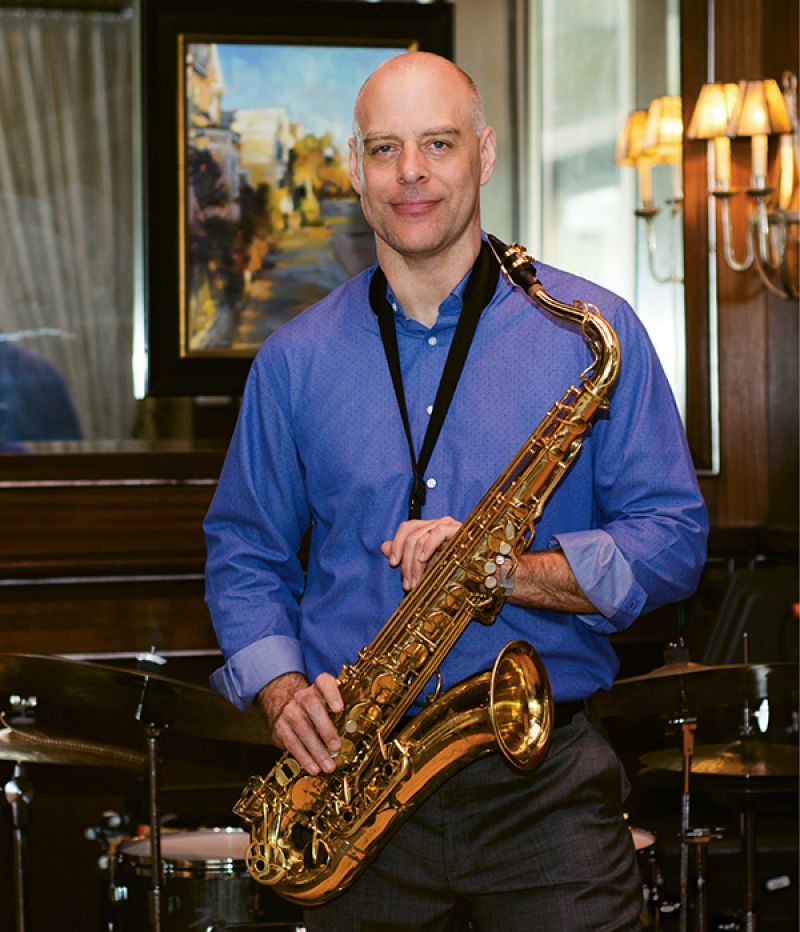
On January 21, saxophonist and Jazz Artists of Charleston artistic director Robert Lewis will take the Gaillard stage during the third Charleston Jazz Festival. Local fans won’t be surprised to see him in this setting: it’s for performing with the Charleston Jazz Orchestra (CJO) that the Washington state native is most recognized (“I’m the big, bald guy in front,” he says), yet it’s not his only gig in town.
After earning a master’s of music from Western Michigan University, Lewis and his wife, Jill Tehaar Lewis, relocated to South Carolina, and he took an adjunct position at the College of Charleston. Today, Lewis continues to serve CofC music students as the director of jazz studies; he runs the program and teaches courses like theory and composition. Charleston Grill and Pane e Vino patrons might also be familiar with his sax’s sounds, as he plays weekly at both restaurants and is often hired for private parties and events. We spoke with Lewis to learn more.
Early years: I was talked into piano lessons when I was around eight or nine, and I seemed to have a little talent. Once I got to middle school, I opted to play the drums. But at that age in school bands, drumming tends to be hitting one thing again and again. I switched to saxophone a semester later and loved it.
Hidden talent: As an undergrad, I went to the University of Idaho on a bassoon scholarship even though I was a saxophone major. I picked the bassoon up in high school, and when high school directors find a kid who can play it, they don’t let him go. Experiencing chamber and orchestral music was beneficial, but I tend to keep the bassoon-playing under-wraps.
On the CJO: I’ve been the lead alto player since the beginning [2008], and I’m one of the primary composers and arrangers. Arrangers take a preexisting piece and create a version that works for a specific ensemble. Part of it is choosing which instrument plays which part; another side of it is more creative: you get to decide if your version will sound just like the original or if it’ll be radically different.
A family affair: My wife and I write and arrange a lot of the music for our ensemble, The In-Between. She sings classically; I improvise; and our pianist, Gerald Gregory, improvises, too. We’ve played Piccolo Spoleto several times and are embarking on a small tour through South Carolina this winter. We also have a new album coming out soon.
Site-specific: A concert is all about making connections with the audience—whereas at some restaurant gigs, the venue doesn’t want you to be too obtrusive. The difference is all about the energy that you, as the musician, project and put out into the room.
Constant student: As a professor, I get to think very deeply about what I’m actually teaching. What is intuitive for me may not be for a student. So I’ve gotten a deeper understanding of what I play by explaining the nuances to someone else. Plus, I’m lucky enough to spend my entire day thinking about music.
Fit to play: Many years ago, I accompanied my son—who now works in Silicon Valley—to a judo class, and I caught the bug. I’m currently a black belt and teach adult classes. It’s a great workout, and a lot more fun than a treadmill—as long as you don’t mind getting bumped and bruised.